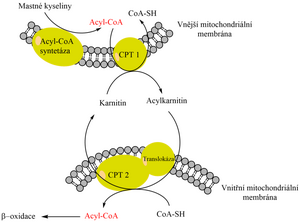Entry of fatty acids into the mitochondrial matrix
The way fatty acids enter the mitochondrial matrix depends on their chain length :
- C10 and shorter enter the matrix freely;
- C12 to C18 enter via the carnitine transporter;
- C18 and longer do not pass through.
Acyl-CoA with C12 – C18 can freely pass through the outer mitochondrial membrane, but the inner membrane is impermeable to it. So the fatty acid has to leave the bond to coenzyme A and bind to a new partner. This is carnitine. The fatty acid transfer between coenzyme A and carnitine is catalyzed by carnitine acyltransferas I (CAT I or carnitine palmitoyltransferase I – CPT I) located on the cytosolic side of the outer mitochondrial membrane.
Carnitine-acylcarnitine translocase in the inner mitochondrial membrane enables the subsequent exchange of carnitine for acylcarnitine, whereby acylcarnitine enters the mitochondrial matrix.
Here, the fatty acid is transferred back from acylcarnitine to coenzyme A via carnitine acyltransferase II (CAT II). Released carnitine leaves the matrix via translocase in exchange for new acylcarnitine. In this way, we transferred acyl-CoA to the mitochondrial matrix, where it undergoes β-oxidation.

